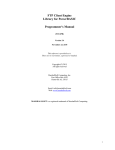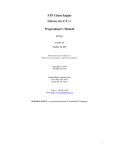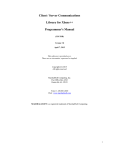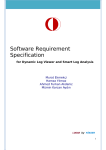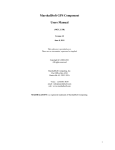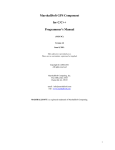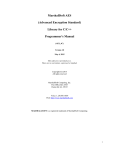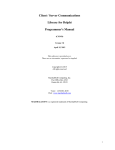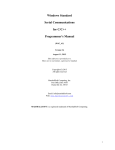Download FCE User`s Manual - MarshallSoft Computing
Transcript
FTP Client Engine Users Manual (FCE_USR) Version 3.2 May 21, 2012 This software is provided as-is. There are no warranties, expressed or implied. Copyright (C) 2012 All rights reserved MarshallSoft Computing, Inc. Post Office Box 4543 Huntsville AL 35815 USA Voice: 1.256.881.4630 Email: [email protected] Web: www.marshallsoft.com MARSHALLSOFT is a registered trademark of MarshallSoft Computing. 1 TABLE OF CONTENTS 1 Introduction 1.1 Documentation 1.2 Technical Support 1.3 How to Purchase 1.4 Updates 1.5 Customer ID 1.6 License File 1.7 Example Programs 2 FTP Client Library Overview 2.1 Keycode 2.2 Dynamic Link Library 2.3 GUI and Console Mode 2.4 Getting Started Using the Library 3 Using FTP 3.1 FTP Basics 3.2 Private and Anonymous Access 3.3 ASCII and Binary Modes 3.4 Passive Mode 3.5 Socket Address in Use Error 3.6 Renaming Files on the Server 3.7 Proxy Servers 3.8 Proxy Protocols 3.9 Firewalls 3.10 Renaming Files "On the Fly" 3.11 Using Append Mode for Uploads 3.12 Using Append Mode for Downloads 3.13 Getting File Lengths 3.14 Adjusting Performance 3.15 Auto Dial 3.16 Secure FTP 3.17 FTP Passwords 3.18 S/Key Password Encryption 3.19 Progress Bars 3.20 Network Connectivity 4 Theory of Operation 4.1 Indirect Method 4.2 Direct Method 5 Development Languages Supported 5.1 Using FCE with Supported Languages 5.2 Using FCE with Unsupported Languages 6 Resolving Problems 7 Versions of FCE 7.1 Evaluation Version 7.2 Academic Version 7.3 Professional Version 8 Legal Issues 8.1 License 8.2 Warranty 9 FCE Function Summary 10 FCE Error Return Code List Page Page Page Page Page Page Page Page Page Page Page Page Page Page Page Page Page Page Page Page Page Page Page Page Page Page Page Page Page Page Page Page Page Page Page Page Page Page Page Page Page Page Page Page Page Page Page Page Page Page 3 3 5 6 7 8 8 8 9 9 9 9 9 10 10 10 10 10 11 11 11 12 13 14 14 15 15 16 17 18 19 19 20 20 21 21 21 22 22 22 23 24 24 24 24 25 25 25 26 27 2 1 Introduction The FTP Client Engine (FCE) is a component DLL library providing direct control of the FTP protocol. The FCE component library can be used for both anonymous and private FTP sessions and can be used with any application capable of calling the Windows API. A simple interface provides the capability to quickly develop FTP software applications to connect to any FTP server, navigate its directory structure, list files, upload files, delete files, append files, and download files using the FTP protocol. The FCE User’s Manual applies to the FTP Client Engine (FCE) for all supported programming languages. It discusses FTP processing as well as language independent programming issues and provides purchasing and licensing information. FTP functions can easily be called from any program written in any programming language (such as C/C++, Visual Studio .NET, Visual C#, Delphi, Visual Basic, VB.NET, PowerBASIC, Visual FoxPro, dBase, Xbase++, COBOL, etc.) that is capable of calling Windows API functions. We have versions of the FTP Client Engine SDK for C/C++ (FCE4C), Delphi (FCE4D), Visual Basic (FCE4VB), PowerBASIC (FCE4PB), Visual FoxPro (FCE4FP), dBase (FCE4DB) and Alaska Xbase++ (FCE4XB). Purchase a developer license for one software development language and use it with all others. All versions of FCE use the same DLLs (FCE32.DLL and FCE64.DLL), however, the examples provided for each version are written and tested for the specified computer development language. The FTP Client Engine DLLs (FCE32.DLL and FCE64.DLL) run under all versions of Windows (Windows 95, Windows 98, Windows ME, Windows 2000, Windows NT, Windows Server 2003, Windows XP, Windows Vista, and Windows 7. The 64-bit version (FCE64.DLL) runs with 64-bit applications running under Vista/x64 and Windows 7 /x64. Fully functional versions of our FTP Client software components are provided so that the developer can test the FCE library in their environment. The evaluation version as well as a list of the many FTP Client library features provided can be found on our website at: http://www.marshallsoft.com/ftp-client-library.htm 3 1.1 Documentation Set The complete set of documentation consists of three manuals. This is the second manual (FCE_USR) in the set. • • • FCE4x Programmer’s Manual (FCE_4x.PDF) FCE User’s Manual (FCE_USR.PDF) FCE Reference Manual (FCE_REF.PDF) The FCE4x Programmer’s Manual is the computer language specific manual. All language dependent programming issues including installation, compiling and example programs are discussed in this manual. Language specific manuals are as follows: • • • • • • • FCE_4C.PDF FCE_4D.PDF FCE_4VB.PDF FCE_4PB.PDF FCE_4FP.PDF FCE_4DB.PDF FCE_4XB.PDF FCE FCE FCE FCE FCE FCE FCE Programmer's Programmer's Programmer's Programmer's Programmer's Programmer's Programmer's Manual Manual Manual Manual Manual Manual Manual for for for for for for for C/C++ Delphi Visual Basic PowerBASIC Visual FoxPro Visual dBase Xbase++ The FCE User’s Manual (FCE_USR) discusses FTP processing as well as language independent programming issues. License and purchase information is also provided. Read this manual after reading the FCE_4x Programmer’s Manual. The FCE Reference Manual (FCE_REF) contains details on each individual FCE function. All documentation can also be accessed online at http://www.marshallsoft.com/support.htm. 4 1.2 Technical Support We want you to be successful in developing your applications using our FTP Client Library! We are committed to providing the best, robust component library that we can. If you have any suggestions or comments, please let us know. If you are having a problem using FCE, refer to Section 6.0 “Resolving Problems”. If you still cannot resolve your problem, email us at [email protected] To avoid having your email deleted by our Spam scanners, begin the subject with “MSC HELP” or with the product name (FCE4C, FCE4VB, etc.). Zip up any attachments and send plain ASCII text email only. Contact us by phone at 1.256.881.4630 between 7:00 AM - 7:00 PM CST Monday-Thursday and 7:00 AM –5:00 PM Friday. The latest versions of our products are available on our web site at http://www.marshallsoft.com and on our anonymous FTP site at ftp://ftp.marshallsoft.com/pub/windows Registered users can update (for a period of one year) to the latest DLL’s at http://www.marshallsoft.com/update.htm 5 1.3 How to Purchase A developer license for the FTP Client Engine Library may be purchased for $115 (USD) for electronic (email) delivery, or $295 (USD) with ANSII C source code for the DLLs. This price is good for one year from the release date. The fastest and easiest way to order is on our web site at http://www.marshallsoft.com/order.htm Multiple copy discounts (3 or more) and site licenses are available. Please call for details. We accept American Express, VISA, MasterCard, Discover, checks in US dollars drawn on a US bank, and International Postal Money Orders (such as Western Union). You can also order by completing INVOICE.TXT (pro forma invoice) and emailing ([email protected]), mailing (see our address at top), or faxing it to us. Our fax number will be provided upon request. For credit card orders, be sure to include the account number, the expiration date, the exact name on the card, and the complete card billing address (the address to which the credit card bill is mailed- not the banks). Please include the Card Verification Code (last 3 numbers printed on the back of Visa, MasterCard and Discover cards, or the 4 numbers of the front of American Express cards.) The cardholder's signature is required on faxed orders. The purchased package includes: • • • FCE32 and FCE64 (for 64-bit programming environment) Library without the “evaluation info” screen. Free downloadable updates to the registered DLLs for one year. Free telephone and email support for one year. 6 1.3.1 Academic Discount We offer an "academic price" with a 40% discount for prepaid email orders to faculty and full time students currently enrolled in any accredited high school, college, or university. The software must be used for educational purposes. The academic discount does not apply to source code. To qualify for the discount, your school must have a web site and you must have an email address at your school. When ordering, ask for the "academic discount", or enter "student at" (or "faculty at") and your schools web site address (URL) in the comments field of the order form on our web site order page. Your order will be sent to your email address at your school. This offer is not retroactive and cannot be used with any other discount. Products bought with academic pricing cannot be used for any commercial purpose. 1.3.2 Source Code Source code is available for the purpose of re-compiling FCE32.DLL. Source code for the DLL library is standard ANSI C. The source code for FCE32.DLL is copyrighted by MarshallSoft Computing and may not be released in whole or in part. There are two ways to order Source Code for the FTP Client Engine Library SDK. (1) Source Code can be ordered at the same time as the Developer’s License for $295 (for both). (2) Source Code can be ordered within one year of purchasing a Developer's License for $200. After one year, a Developer’s License update must be purchased prior to purchasing the source code. 1.4 Updates When a developer license is purchased for the FTP Client Engine Library SDK, the developer will be sent a new set of DLLs plus a license file (FCExxxxx.LIC) that can be used to update the registered DLL (does not include source code) for a period of one year from purchase. Updates can be downloaded from http://www.marshallsoft.com/update.htm After one year, the developer license must be updated to be able to download updates. The developer license can be updated for $30 if ordered within one year from the original purchase (or previous update). After one year, licenses can be updated for $55 ($75 after 3 years). Source code previously purchased may be updated for $100 in addition to the cost of the update ($30, $55 or $75). Note that the registered DLL’s never expire. 7 1.5 Customer ID The Customer ID is the 5 digits following the product name (FCE) in the license file. For example, customer 12345 would receive license file FCE12345.LIC. Provide the Customer ID in the SUBJECT of an email when contacting us for technical support (FCE4C 12345). 1.6 License File A license file, FCExxxx.LIC, where “xxxx” is the 4 or 5- digit customer ID is provided with each developer license. The license file is an encrypted binary file used for updating FCE as explained in section 1.4 “Updates”. The license file is required in order to create (or update) the registered DLLs. The license file can be found in the /DLLS directory created after SETUP is run. 1.7 Example Programs The example programs are discussed in the FCE Programmer's Manual: • • • • • • • FCE_4C FCE_4D FCE_4VB FCE_4PB FCE_4FP FCE_4DB FCE_4XB FCE FCE FCE FCE FCE FCE FCE Programmer's Programmer's Programmer's Programmer's Programmer's Programmer's Programmer's Manual Manual Manual Manual Manual Manual Manual for for for for for for for C/C++ Delphi Visual Basic PowerBASIC Visual FoxPro Visual dBase Xbase++ The purpose of the example programs is to demonstrate how to call FCE functions. Please read through the comments in the example program source code before compiling. 8 2 FTP Client Library Overview The FTP Client Engine Library has been tested on multiple computers running Windows 95/98/Me/2003/XP/Vista/Vista x64/Win 7/Win 7 x64 and Windows NT/2000. 2.1 Keycode When a developer license is purchased, the developer will receive a new set of DLLs and a keycode for the FCE DLL's. Pass this keycode as the argument to fceAttach. The keycode will be found in the file named “KEYCODE”. The keycode for the evaluation version is 0. The keycode for the registered version will be a unique 9 or 10 digit number. Note: Your keycode is NOT your Customer ID/Registration number. 2.2 Dynamic Link Library The FTP Client Engine Library SDK includes a Win32 [FCE32.DLL] and Win64 [FCE64.DLL] dynamic link libraries (DLL). A DLL is characterized by the fact that it need not be loaded until required by an application program and that only one copy of the DLL is necessary regardless of the number of application programs that use it. Contrast this to a static library that is bound at link time to each and every application that uses it. 2.3 GUI and Console Mode FCE functions can be called from WIN32 console mode programs as well as GUI programs. A "console mode" program is a Windows 95/98/Me/NT/2000/2003/XP/Vista/7 WIN32 command line program running in a command window. Although console mode programs look like DOS programs, they are WIN32 programs that have access to the entire Windows address space. 2.4 Getting Started Using the Library The first FTP Client Engine (FCE) function that should be called is fceAttach, which initializes the FCE library and allocates necessary resources. fceAttach is typically called in the initialization section of your application. After fceAttach is called, you are ready to connect to a FTP server with fceConnect. Once connected, you are ready to call the other FCE functions. After completing your FTP session, the connection to the server can be closed with fceClose. The fceClose function should not be called if the previous fceConnect failed. Before exiting your application, fceRelease should be called. fceRelease should not be called if fceAttach failed. The best way to get familiar with FCE is to try out one of the example programs. The example programs are described in the FCE4x Programmer's Manual. . The “x” in FCE_4x specifies the host programming language such as C for C/C++, VB for Visual Basic, etc. the example source is written in. • • • • • • • FCE_4C FCE_4D FCE_4VB FCE_4PB FCE_4FP FCE_4DB FCE_4XB FCE FCE FCE FCE FCE FCE FCE Programmer's Programmer's Programmer's Programmer's Programmer's Programmer's Programmer's Manual Manual Manual Manual Manual Manual Manual for for for for for for for C/C++ Delphi Visual Basic PowerBASIC Visual FoxPro Visual dBase Xbase++ 9 3 Using FTP 3.1 FTP Basics The FTP (File Transfer Protocol) protocol is defined by Internet document RFC 959. It is used to copy files between a FTP client and a FTP server over a TCP/IP connection using well-known port 21. There are two types of FTP connections: private and anonymous. However, some FTP servers do not accept anonymous connections. Three parameters are necessary in order to connect to a FTP server, as follows: • • • Host name (or IP address) of the FTP server. User name. User password. These FTP parameters are hard coded in most of the examples. However, these parameters could be read from the keyboard, from a file, from a dialog box at runtime, etc., as well as being hard coded. 3.2 Private and Anonymous Access For private connections, the users account name and password must be specified. Some FTP servers allow "anonymous" access, which is usually download only. For anonymous connections, the user name is "anonymous" and the password is the user's email address. 3.3 ASCII and Binary Access Modes The default FTP access mode is ASCII text. In order to upload or download any file that is not ASCII text, the transfer mode must be set to binary with the fceSetMode function first. A binary file uploaded or downloaded in ASCII mode may be corrupted. 3.4 Passive Mode FCE supports "Passive" mode. Passive mode means that the server specifies the data port rather than the client when listing or transferring files. Using passive mode is often necessary to get past a firewall. Passive mode is an optional FTP command, so that although most FTP servers support passive mode, there are some that do not. Passive mode can be enabled by calling: fceSetInteger(Chan, FCE_SET_PASSIVE, 1) The use of passive mode is recommended when possible. 10 3.5 "Socket Address Already In Use" Error. The FTP protocol specifies that data sockets are reserved after use for some fixed period of time. This means that a data socket cannot be immediately re-used. When making multiple calls to list or transfer files, FCE will increment the data socket number. However, if you terminate and then restart your application while the FTP server still has your last data socket reserved, and attempt to list or transfer files, you will get the error "socket address already in use". There are three solutions to this problem: (1) Wait a minute or so, then try again. (2) Use PASSIVE mode [fceSetInteger(Chan, FCE_SET_PASSIVE, 1)]. (3) Specify the port yourself by calling fceSetInteger(Chan, FCE_SET_DATA_PORT, port-number). 3.6 Renaming Files on the Server. Files can be renamed on the FTP server by using the fceCommand function. For example, to rename the file "oldname.txt" to "newname.txt" on the server, use (C/C++ example): // rename "oldname.txt" to "newname.txt" on the server Code = fceCommand(Chan, "RNFR oldname.txt") Code = fceCommand(Chan, "RNTO newname.txt") Also refer to Section 3.10, ‘Renaming Files "On the Fly"’. 3.7 Proxy Servers In order to use a FTP proxy server, the FTP client connects to the proxy server, and then the proxy server connects to the remote FTP server. The sequence of connection events is as follows: • • • • The client connects to the FTP proxy server using the FTP port as required by the proxy server. The client provides authentication information to the proxy server, if required. The client provides user name and password for the remote FTP server to the proxy server. The FTP proxy server connects to the remote FTP server. The proxy server requires that a particular port (not well known port 21) be used when connecting to it. The proxy server port number is specific to the particular proxy server. Refer to the documentation for the specific FTP proxy server to find out the port number and the method for specifying connection parameters such as the user name and password. The most common method for providing remote server parameters to a proxy server is sometimes known as "PROXY USER". For example, to connect to ftp.marshallsoft.com as user "anonymous" with password "[email protected]" through the proxy server running at 10.0.0.1 on proxy port 4421; fceSetInteger(0, FCE_SET_FTP_PORT, 4421) fceConnect(0, "10.0.0.1", NullString, NullString) fceCommand(0, "USER [email protected]") fceCommand(0, "PASS [email protected]") Note that the user name and password in the above example are for the remote FTP server, not for the proxy FTP server. The "NullString" refers to a string (or buffer) in which the first byte is a hex zero. Refer to the PROXY example for a complete program. Check the documentation provided with a particular proxy server for a description of the proxy protocol that it requires. Also refer to Section 3.8, “Proxy Protocols”. 11 3.8 Proxy Protocols There are no formally defined proxy connection protocols. However, the following lists the most common proxy connection protocols. Refer to the PROXY example program for an example using the “PROXY USER” connection protocol. Note that ProxyUser and ProxyPass are not always used. The following parameters are used for connection to a remote FTP site through a proxy server. ProxyServer ProxyUser ProxyPass ProxyPort = = = = Proxy Proxy Proxy Proxy server name or IP address. user name (optional). password (optional). port number. Consult your proxy documentation. RemoteServer = Remote FTP server name or IP address. RemoteUser = Remote FTP server user name. RemotePass = Remote FTP server password. 3.8.1 "RemoteUser@RemoteServer" Protocol (PROXY USER) USER RemoteUser@RemoteServer PASS RemotePass 3.8.2 "User After Login" Protocol. Also known as the "Double Login" protocol. USER PASS USER PASS ProxyUser ProxyPass RemoteUser@RemoteServer RemotePass 3.8.3 "ProxyUser@RemoteServer ProxyUser" Protocol. USER ProxyUser@RemoteServer ProxyUser PASS RemotePass 3.8.4 "ProxyUser@RemoteUser@RemoteServer" Protocol. USER ProxyUser@RemoteUser@RemoteServer PASS RemotePass 3.8.5 "Proxy Open" Protocol. OPEN RemoteServer USER RemoteUser PASS RemotePass Check the documentation provided with a particular proxy server for a description of the proxy protocol that it requires. 12 3.9 Firewalls Firewalls operate transparently with respect to all TCP/IP programs, monitoring inbound and outbound traffic. Firewalls can filter packets based on their contents, source addresses, destination addresses, and port numbers. If the traffic meets the criterion of the firewall, it is allowed, otherwise it is not. Firewalls are often combined with proxy servers. Firewalls usually require the use of passive mode. Refer to Section 3.4 "Passive Mode". When a client program attempts to connect to a FTP server, the first thing that the server does is accept the connection, then send its greeting message - all before the actual logon. If a server's greeting message is not received, then one of the following may have occurred: an incorrect server name or IP address was specified, the wrong port (a few servers don't use standard port 21) was specified, there is a connectivity problem (problem with cable, DSL, Windows itself, etc.), or a firewall is blocking the connection. If a connection to the server is successful, and all commands work up to the point prior to attempting to get a listing or upload/download a file, then the problem is almost always that the data port chosen is being blocked on one side or the other. Often using passive mode (which allows the server to choose the data port) will resolve this problem, although passive mode is not supported by all servers. If the connection is being blocked by a local firewall (as opposed to the server's firewall) then the local firewall will need to be reconfigured to unblock a range of data ports. Note that a range of data ports can be specified by using: fceSetInteger(FCE_SET_FIRST_DATA_PORT, first-data-port-to-use) fceSetInteger(FCE_SET_LAST_DATA_PORT, last-data-port-to-use) Once a data port is used, the port is freed, but it cannot be reused for a period of time determined by the server. To be on the safe side, use one data port for each file listing/upload/download that will occur within any 60-second time period. 13 3.10 Renaming Files "On The Fly" Files can renamed as they are being uploaded or downloaded by specifying the filename in "oldname:newname" format. For example, to download the file "serverfile.txt" from an FTP server renamed as "myfile.txt" on the client computer, call fceGetFile(Chan, "serverfile.txt:myfile.txt") Note that there are no extra spaces in the filename string. The default filename delimiter is the ':' character, but can be changed to any character necessary. For example, to change the filename delimiter from ':' to '$', call fceSetInteger(Chan, FCE_SET_RENAME_DELIMITER, '$') 3.11 Using Append Mode for Uploads Provided that a FTP server supports it, uploads can be appended to the existing file of the same name (on the server). This can be done by setting append mode and (optionally) a file offset before calling fcePutFile. For example, to append file "myfile.txt" to the server, fceSetInteger(Chan, FCE_SET_APPEND_MODE, 1) fcePutFile(Chan, "myfile.txt") To append "myfile.txt", but begin reading the file at file offset 1024 on the client computer, fceSetInteger(Chan, FCE_SET_APPEND_MODE, 1) fceSetInteger(Chan, FCE_SET_CLIENT_OFFSET, 1024) fcePutFile(Chan, "myfile.txt") In order to continue an interrupted upload, the offset used should be the existing size of the file on the server. The client offset (if specified) applies only to the client computer not to the server. The server file offset cannot be specified for uploads. Append mode and the file offset must be set for every file before calling fcePutFile. 14 3.12 Using Append Mode for Downloads Provided that an FTP server supports it, downloads can be appended to the existing file of the same name on the client computer. This is done by setting append mode, a server file offset, and a client file offset before calling fceGetFile. For example, to download file "myfile.txt"' beginning at file offset 1024 on the server to the client computer, also at file offset 1024, fceSetInteger(Chan, FCE_SET_APPEND_MODE, 1) fceSetInteger(Chan, FCE_SET_SERVER_OFFSET, 1024) fceSetInteger(Chan, FCE_SET_CLIENT_OFFSET, 1024) fceGetFile(Chan, "myfile.txt") In order to continue an interrupted download, both the client file offset and the server file offset should be set to the existing size of the file on the client computer. Append mode and the file offsets must be set for every file before calling fceGetFile. 3.13 Getting File Lengths If your FTP server supports the "extended" FTP command "SIZE", the fecGetFileSize command can be used to get the size of a file on the FTP server. Otherwise, the file size will have to be retrieved from the file listing. According to the FTP protocol standard, there is no standard for the format of full FTP listings returned by the server. The format will vary by host operating system, and sometimes between various makes of FTP servers. However, most servers return the full listing exactly as reported by the host operating system. For UNIX, it is typically "ls -l". For Windows, it is typically "dir". To get the file length of a particular file, request a full listing entry by calling fceGetList(Chan, FCE_FULL_LIST, DataBuffer, DataBufferSize) then call fceExtract to extract each field in turn. One of the fields, depending on the host's operating systems, will be the field length. 15 3.14 Adjusting Performance 3.14.1 Max Performance A few FTP servers have trouble receiving large buffers sent by the client. However, for most servers, the write performance can be increased by enlarging the write buffer size from 1024 (default value) to 8192 and reducing the sleep time set to 0: fceSetInteger(0, FCE_SET_WRITE_BUFSIZE, 8192) fceSetInteger(0, FCE_SET_SLEEP_TIME, 0) If uploading is much slower than you believe that it should be, try calling fceSetInteger(0, FCE_STATUS_BEFORE_WRITE, 0) This will direct FCE to not check the WRITE status of a socket before writing to it. 3.14.2 Slow Servers There are some FTP servers that, for various reasons, cannot keep up with the load of FTP requests from FTP clients. In order to make it easier for those servers, FCE can be programmed to run slower. For example, fceSetInteger(0, FCE_SET_SLEEP_TIME, 150) fceSetInteger(0, FCE_SET_MIN_LINE_WAIT, 250) fceSetInteger(0, FCE_SET_MIN_RESPONSE_WAIT, 3000) 16 3.15 Auto Dial 3.15.1 Auto Dial for Windows 95/98/Me To allow Dial-Up Networking (DUN) to dial up an ISP when the accessing the Winsock (WIN32 only): (1) Open the DUN folder in "My Computer", and choose "Connections/Settings" from menu bar. Uncheck "prompt for information before dialing" and choose "Don't prompt to use Dial-Up Networking". (2) Use the Windows REGEDIT program to change value "00 00 00 00" to the value "00 00 00 01" in the Windows Registry for the entry HKEY_CURRENT_USER/Software/Microsoft/Windows/CurrentVersion/InternetSettings/EnableAutodial` (3) Use the Windows REGEDIT program to change value "00 00 00 00" to the value "00 00 00 01" in the Windows Registry for the entry HKEY_CURRENT_USER/Software/Microsoft/Windows/CurrentVersion/InternetSettings/EnableAutodisconnect. (4) Use the Windows REGEDIT program to change value "14 00 00 00" to the value "01 00 00 00" in the Windows Registry for the entry HKEY_CURRENT_USER/Software/Microsoft/Windows/CurrentVersion/InternetSettings/DisconnectIdleTime This changes the idle time (until disconnect) from 20 minutes (hex 14) to one minute. 3.15.2 Auto Dial for Windows NT Windows NT and XP users can control auto dialing by editing the setting in the “Dial-Up Networking” (DUN) window. Choose “More”, “User Preferences”, then “Appearance”. The Dial-Up Networking window can also be displayed by executing the Microsoft Windows program RASPHONE.EXE. 3.15.3 Auto Dial for Windows 2000/XP/Vista Start Windows help, then type "autodial", then click "configuring". Follow all directions, including "notes". Note that the "Remote Access Auto Connection Manager" must be enabled. 3.15.4 MarshallSoft DUN Dialer The MarshallSoft DUN Dialer (MDD) can dial up (and hang up) under program control. MDD works under all Windows 32-bit operating systems (Win 95, 98, Me, XP, Vista, NT, 2000,2003). For more information, see the MDD product page at www.marshallsoft.com/mdd4c.htm (for C/C++), www.marshallsoft.com/mdd4vb.htm (for Visual Basic), etc. The cost for MDD is discounted when ordered at the same time as FCE. 17 3.16 Secure FTP The FTP protocol itself is not secure. If sensitive or private data is to be exchanged, some form of FTP security should be considered. Unfortunately, there are quite a few differing solutions to FTP security, and none of them are part of the standard FTP protocol. There are, however, several solutions to the problem of FTP security. The FTP Client Engine supports 3.16.1 through 3.16.4 below as well as S/KEY password encryption (section 3.18). 3.16.1 Use a secret port. Changing the FTP server's port provides a minimal degree of security. The idea is that hackers will not know which port to attack. The port chosen should be changed on a regular basis. Most FTP servers and clients can use non-standard ports. 3.16.2 Encrypt all data. Encrypt all files using strong encryption such as "Pretty Good Privacy". Although hackers may be able to intercept FTP passwords and download copies of your encrypted files, they will not be able to decode them unless they know the encryption key. Standard FTP clients and servers can be used. 3.16.3 Implement VPN. Set up a "Virtual Private Network", which will encrypt all traffic between VPN nodes. VNP products may be either software or hardware, and are widely available. They also allow the use of standard FTP servers and clients. 3.16.4 Use Secure FTP proxy servers. Similar to VPN, secure FTP proxy servers can be used to automatically encrypt all traffic between two end points. Using secure FTP proxy servers allows the use of standard FTP servers and clients. 3.16.5 Use SSL, TSL, SSH, or SFTP protocols. Use one of several "secure" FTP servers that typically implement SSL, TSL, or SFTP security protocols. This approach also requires the use of an FTP client using the same security protocol and requires X.509 certificates. Currently the FTP Client Engine does not support these protocols, however, they are included in the documentation for completeness. 18 3.17 FTP Passwords When a connection is made to a FTP server, a user name and password are normally supplied. However, occasionally the FTP server will be configured to require “no password”. This can mean two different things: (1) The PASS command should not be sent. To do this, pass an empty string (a string whose first element is a NUL) as the password argument to fceConnect. (2) The PASS command should be sent by itself. To do this, pass a string consisting of a single space character as the password argument to fceConnect. 3.18 S/KEY Password Encryption The S/KEY "One-Time Password System", defined by RFC 2289, encrypts passwords before sending them. The actual password is never transmitted in the clear as is the case for standard FTP. A FTP server that supports the one time password system will respond to the client's USER command with the challenge string "otp-md5 <sequence> <seed>" to which the client responds with the 6 word password phrase as calculated from the users password according to RFC 2289. For example, R: S: R: S: R: 220 Serv-U FTP Server v6.3 for WinSock ready... USER mike 331 Response to otp-md5 999 hello required for skey. PASS NEIL JULY NONE EMIT FLEW MUDD 230 User logged in, proceed. If "otp-md5" is not seen, FCE sends the user's password normally (in the clear) as required by the FTP protocol. Thus, S/KEY password encryption is performed automatically when FCE connects to an S/KEY enabled FTP server. The function fceGetInteger(0, FCE_SKEY_WAS_SEEN) will return TRUE (none zero) if the challenge string "otp-md5" was seen in the server's response to the client's USER command. There are several FTP servers that support S/KEY password encryption. For Windows, • • • Titan FTP Server (http://www.southrivertech.com) Serv-U FTP Server (http://www.serv-u.com) Globalscape FTP Server (http://www.globalscape.com) 19 3.19 Progress Bars Direct mode (calling fceDriver) must be used in order to periodically (for example, each second) get the transfer byte count as the upload/download progresses. In order to implement an upload progress bar, it is necessary to know the size of the file to be uploaded, which can be found by calling fceGetLocalFSize. For implementing a download progress bar, the size of the file on the server must be known. This is complicated by the fact that there is NO standard (long) listing format. However, the file size is almost always the first numeric field (beginning with the third), and can be found by calling fceFileLength. The percentage uploaded is computed as BytesWritten = fceGetInteger(0, FCE_GET_FILE_BYTES_SENT) FileSize = fceGetLocalFSize(0, FilenamePointer) PerCentage = (100 * BytesWritten) / FileSize and the percentage downloaded is computed as BytesRead = fceGetInteger(0, FCE_GET_FILE_BYTES_RCVD) FileSize = fceFileLength(LongListingPointer, 3, 7) PerCentage = (100 * BytesRead) / FileSize Also see the WINFTP example program that displays the percentage uploaded/downloaded at runtime. 3.20 Network Connectivity It is possible to detect loss of network connectivity in some situations by calling fceIsConnected(Channel) However, depending on many factors, loss of network connectivity cannot always be detected. The only 100% method of detecting loss of connectivity to the server is to send a "NOOP" command to the server and then reading its response. Calling the function fceHello can perform this. fceHello(Channel) 20 4 Theory Of Operation The FTP Client Engine (FCE) is state driven. This means that each call to FCE functions (that access the server) is broken down into sequential steps, each of which can be performed within a second or so. There are two ways in which FCE is used: (1) indirect use of the state engine, and (2) direct use of the state engine. 4.1 Indirect Method The first (or "indirect") way to use the FCE library is to allow all FCE function calls to automatically call the FCE driver (fceDriver) before returning. This is the default way that FCE operates. The major advantage of this approach is that each FCE function returns only after it has completely finished. The disadvantage of this approach is that some functions may run for a considerable amount of time during which time the calling application must wait. Refer to the GET example program for an illustration of this approach. 4.2 Direct Method The second (or "direct") way that the FCE state driver is used is to call it (fceDriver) directly. In order to operate this way, the function fceSetInteger must be called to set the AUTO_CALL flag to off: fceSetInteger(Chan, FCE_SET_AUTO_CALL_DRIVER, 0) After the above statement is executed, the state driver (fceDriver) must be called after all of the other FCE functions that access the server. For example (code example), ... enable direct mode (disable indirect mode). fceSetInteger(Chan, FCE_SET_AUTO_CALL_DRIVER, 0) ... connect to server. Code = fceConnect(...) If Code < 0 Then ... handle error here. End If ... run the driver. Loop ... call the driver Code = fceDriver(Chan) If Code < 0 Then ... handle error here. Exit Loop End If If Code = 0 Then ... fceDriver has finished. Exit Loop End If ... display progress or do other processing here. End Loop ... enable indirect mode (disable direct mode). fceSetInteger(Chan, FCE_SET_AUTO_CALL_DRIVER, 1) The major advantage of the direct approach is that the calling application can perform other work such as reporting the progress of large downloads. The disadvantage is the extra code that must be written to call fceDriver. Refer to the WINFTP example program for an illustration of this approach. 21 5 Development Languages Supported We have versions of the FTP Client Engine (FCE) component library for C/C++ and .NET (FCE4C), Borland Delphi (FCE4D), Visual Basic and VB.NET (FCE4VB), PowerBASIC (FCE4PB), Visual FoxPro (FCE4FP), dBase (FCE4DB), and Alaska Xbase++ (FCE4XB). All versions of FCE use the same DLLs (FCE32.DLL and FCE64.DLL). Evaluation versions for these may be downloaded from our website at http://www.marshallsoft.com/ftp-client-library.htm The FTP Client Engine DLL’s can also be used with any application written in any language capable of calling the Windows (95/98/Me, NT/2000/XP/2003/Vista/7) API. 5.1 Using FCE with Supported Languages. Once a developer license is purchased for a particular programming language version of the FTP Client Engine SDK (FCE), the same license can be used with all other supported programming languages. Supported languages are C/C++, Visual Basic, PowerBASIC, Delphi, Visual FoxPro, Visual dBase, Xbase++, and (Fujitsu) COBOL. For example, assume that you have previously downloaded and installed the registered version of FCE4C and now you want to also call FCE functions from Visual Basic. 1. Make a backup copy of FCE32.DLL and FCE64.DLL found in the Windows directory (\WINDOWS or \WINNT). 2. Download and install the evaluation version of FCE4VB (http://www.marshallsoft.com/fce4vb.htm) into a separate directory from FCE4C. 3. Compile and run the Visual Basic FCEVER example program found in the APPS directory created in step 2 above. It should display the pop-up evaluation screen. 4. Restore FCE32.DLL and FCE64.DLL saved in step 1 above. 5. Paste the key code value found in (the registered version of FCE4C) KEYCODE.H into KEYCODE.BAS. 6. Run the Visual Basic FCEVER example program again. It should no longer display the pop-up screen. A quicker and easier way would be to request multiple programming versions of FCE when a developer license is purchased. There is no additional charge. 5.2 Using FCE with Unsupported Languages The FTP Client Engine DLL can be used with any application written in any language capable of calling the Windows (95/98/ME, NT/2000/XP/2003/Vista/7) API. Declaration files have been defined for the following languages: C/C++ and .NET Visual Basic and VB NET VBA (Excel, Access,…) PowerBASIC Borland Delphi Fujitsu COBOL Fortran Visual FoxPro Visual dBase Alaska Xbase++ FCE.H FCE32.BAS FCE32.BAS FCE32.PBI FCE32.PAS FCE32.CBI FCE32ABS.INC and FCE32DEC.INC FCE32.FOX FCE32.CC FCE32.CH Additional declaration files will be added. Email us if you need a declaration not listed above. If you have interfaced FCE to an unusual language, email us the declaration file! 22 6 Resolving Problems First, be sure you are passing the proper keycode. Refer to section 2.1 "Keycode". Before attempting to run any of the example programs, you should already be able to connect to the Internet (or your TCP/IP LAN) and run your normal FTP client, such as the Microsoft command line FTP client FTP.EXE (in the Windows directory). If you have trouble connecting to an FTP server, try using the IP address instead of the server name. If using the IP address works but the server name does not, the problem lies with the Domain Name System (DNS) lookup. If this does not solve your connection problem, try connecting using TELNET, located in the Windows or Windows/System32 . If you cannot get your application to run properly, first compile and run the example programs. If you call us to report a possible bug in the library, the first thing we will ask is if the example programs run correctly. All example programs have been compiled and tested. Be sure to test the code returned from all FCE functions. Then, call fceErrorText to get the text associated with the error code. All functions return an integer code. Negative values are always errors. For example (C Example): Code = fceConnect(0,"ftp.marshallsoft.com","mike", "mike"); if(Code<0) {static char Buffer[64]; fceErrorText(0,Code,Buffer,64); printf("Error %d: %s\n", Code, Buffer); } Another good idea is to turn on logging by calling fceSetString(Chan, FCE_LOG_FILE, logfilename) If you encounter a problem that you cannot resolve, email us at [email protected]. To avoid having your email deleted by our Spam scanners, begin the subject with FCE or MSC HELP. Zip up any attachments and send plain ASCII text email only. If you still get the evaluation screen (popup window) after purchasing a developer license, the problem is that Windows is finding the evaluation DLL before the registered DLL. The solution is to delete (or zip up) all evaluation versions of FCE32.DLL (or FCE64.DLL) and run the SETUP program again. If you get "error -74" when calling fceAttach, the problem is that the keycode passed to fceAttach does not match the keycode in the DLL's. This is caused by (1) using the evaluation keycode (value = 0) with the registered DLL, or (2) using the registered keycode with the evaluation DLL. We recommend the following steps if you believe that you have discovered a bug in the library: (1) Create the smallest, simplest test program possible that demonstrates the problem. (2) Document your exact machine configuration and what error the test program demonstrates. (3) Email to [email protected] the example source and log file. If the problem is an error in the library and can be solved with an easy work-around, we will publish the work-around. If the problem requires a modification to the library, we will make the change and make the modified library available to our customers without charge. Review the FCE Programmer’s and Reference Manuals. We also suggest reading Section 3 "Using FTP". 23 7 Versions of FCE The FTP Client Engine (FCE) component library is available in three versions. All three versions have identical functionality. 7.1 Evaluation Version The evaluation version can be differentiated from the other two versions by: (1) The evaluation reminder screen is displayed at startup. (2) The evaluation version may not be used for commercial purposes. (3) The evaluation version may be used for 30days. 7.2 Academic Version The academic version can be differentiated from the other two versions by: (1) There is no evaluation reminder screen. (2) The academic version is for academic purposes only and may not be used for commercial purposes. 7.3 Professional Version The professional version can be differentiated from the other two versions by: (1) There is no evaluation reminder screen. (2) The DLL is branded with your company name. (3) Your branded DLLs may be distributed with your compiled applications. The professional version compiled DLL may be distributed royalty free with your compiled applications as specified by the software license. However, the Keycode to the DLL can NOT be distributed. The Professional version may be used for commercial purposes. Licensing information is provided in Section 10.1 24 8 Legal Issues 8.1 License This license agreement (LICENSE) is a legal agreement between you (either an individual or a single entity) and MarshallSoft Computing, Inc. for this software product (SOFTWARE). This agreement also governs any later releases or updates of the SOFTWARE. By installing and using the SOFTWARE, you agree to be bound by the terms of this LICENSE. If you do not agree to the terms of this LICENSE, do not install or use the SOFTWARE. MarshallSoft Computing, Inc. grants a nonexclusive license to use the SOFTWARE to the original purchaser for the purposes of designing, testing or developing software applications. Copies may be made for back-up or archival purposes only. This product is licensed for use by only one developer at a time. All developers working on a project that includes a MarshallSoft Software SDK, even though not working directly with the MarshallSoft SDK, are required to purchase a license for that MarshallSoft product. The academic registered DLL's may not be distributed under any circumstances, nor may they be used for any commercial purpose. The professional registered DLL's may be redistributed (without royalty) as part of the user's compiled application. The registered DLL's may NOT be distributed as part of any software development system (compiler or interpreter) without our express written permission. When the software is registered, a keycode will be provided, which enables access to the registered DLL's. This key-code may NOT be distributed or made known. The SOFTWARE is owned by MarshallSoft Computing, Inc. and is protected by United States copyright laws and international treating provisions. This SOFTWARE is being licensed and not sold. 8.2 Warranty MARSHALLSOFT COMPUTING, INC. DISCLAIMS ALL WARRANTIES RELATING TO THIS SOFTWARE, WHETHER EXPRESSED OR IMPLIED, INCLUDING BUT NOT LIMITED TO ANY IMPLIED WARRANTIES OF MERCHANTABILITY AND FITNESS FOR A PARTICULAR PURPOSE, AND ALL SUCH WARRANTIES ARE EXPRESSLY AND SPECIFICALLY DISCLAIMED. NEITHER MARSHALLSOFT COMPUTING, INC. NOR ANYONE ELSE WHO HAS BEEN INVOLVED IN THE CREATION, PRODUCTION, OR DELIVERY OF THIS SOFTWARE SHALL BE LIABLE FOR ANY INDIRECT, CONSEQUENTIAL, OR INCIDENTAL DAMAGES ARISING OUT OF THE USE OR INABILITY TO USE SUCH SOFTWARE EVEN IF MARSHALLSOFT COMPUTING, INC. HAS BEEN ADVISED OF THE POSSIBILITY OF SUCH DAMAGES OR CLAIMS. IN NO EVENT SHALL MARSHALLSOFT COMPUTING, INC.'S LIABILITY FOR ANY SUCH DAMAGES EVER EXCEED THE PRICE PAID FOR THE LICENSE TO USE THE SOFTWARE, REGARDLESS OF THE FORM OF THE CLAIM. THE PERSON USING THE SOFTWARE BEARS ALL RISK AS TO THE QUALITY AND PERFORMANCE OF THE SOFTWARE. Some states do not allow the exclusion of the limit of liability for consequential or incidental damages, so the above limitation may not apply to you. This agreement shall be governed by the laws of the State of Alabama and shall inure to the benefit of MarshallSoft Computing, Inc. and any successors, administrators, heirs and assigns. Any action or proceeding brought by either party against the other arising out of or related to this agreement shall be brought only in a STATE or FEDERAL COURT of competent jurisdiction located in Madison County, Alabama. The parties hereby consent to in personam jurisdiction of said courts. 25 9 FCE Function Summary Refer to the FCE Reference Manual (FCE_REF) for detailed information on the FCE functions. A oneline summary of each function follows. There are 40 functions in the FTP Client Component (FCE) library. fceAbort fceAttach fceByteToShort fceClose fceCommand fceConnect fceDelFile fceDelServerDir fceDriver fceErrorText fceExtract fceFileLength fceGetFile fceGetInteger Abort FTP session. Attach (initialize) FCE for use. Converts from 8-bit ASCII characters to 16-bit. Close connection opened with fceConnect. Sends arbitrary command to server [Rename,get status, Connect to FTP server. Delete file on server. Delete server directory. FCE direct mode driver. Get text associated with error code. Extract line from LIST buffer. Gets file length for file on server. Download (receive) file. Get FCE integer parameter for FTP processing. fceGetList fceGetLocalDir fceGetLocalFList fceGetLocalFSize fceGetServerDir fceGetString Get list of files on server. Get local directory. Gets list of files in up/download directory. Gets size of file in up/download directory. Get server directory. Get FCE string parameter. fceGetTicks fceHello fceIsConnected fceMakeServerDir fceMatchFile fcePutFile fceRelease fceSetInteger Get system ticks. Send "NOP" command. Get current connection status. Create directory on server. Match next filename in list. Upload (transmit) file to server. Release FCE. Set FCE integer parameter for FTP processing. etc] [GET RESPONSE, CONNECT STATUS, BYTES SENT/RECEIVED, DATA PORT, etc.] [GET LINE COUNT, SERVER IP, LOCAL IP, FULL RESPONSE etc.] [SET DATA PORT.FTP PORT, WRITE BUFSIZE, APPEND MODE, SLEEP TIME, HIDE PASSWORD, PASSIVE, MASTER INDEX, RESPONSE WAIT, etc.] fceSetLocalDir fceSetMode fceSetServerDir fceSetString Set Set Set Set local directory. XFER mode (ASCII or Binary). server directory. FCE parameter string. fceShortToByte fceToInteger fceGetFileSize fceGetFileTime fceGetDirFiles fcePutDirFiles Converts from 16-bit ASCCII characters to 8-bit. Converts ASCII text to integer. Get size of file on server. Get date & time stamp of file on server. Download (receive) all files in a directory. Upload (send) all files in a directory. [SET LOG FILE, BIND TO LOCAL IP, WRITE TO LOG] 26 10 FCE Error Return Code List The complete list of FTP Client Engine Component (FCE) error codes follows. FCE_ABORTED FCE_ACCEPT_SILENT FCE_ALREADY_ATTACHED FCE_BAD_KEY_CODE FCE_BAD_STATUS_FLAG FCE_BUFFER_OVERFLOW FCE_BUFFER_TOO_SMALL FCE_CANNOT_ALLOC FCE_CANNOT_COMPLY FCE_CANNOT_CREATE_SOCK FCE_CANNOT_OPEN FCE_CHAN_OUT_OF_RANGE FCE_CONNECT_ERROR FCE_EOF FCE_EXPIRED FCE_FILE_IO_ERROR FCE_INVALID_SOCKET FCE_IS_BLOCKING FCE_LISTEN_ERROR FCE_LISTENER_SILENT FCE_MODE_NOT_AB FCE_NO_GREETING FCE_NO_HOST FCE_NO_SERVER FCE_NO_SOCK_ADDR FCE_NOT_ATTACHED FCE_NOT_COMPLETED FCE_NOT_SERVER FCE_PASS_NULL_ARG FCE_PASV_ERROR FCE_PORT_RANGE FCE_SERVER_ERROR FCE_SERVER_NULL_ARG FCE_SOCK_READ_ERROR FCE_SOCK_WRITE_ERROR FCE_TIMED_OUT FCE_USER_NULL_ARG Internal checksum fails! Timed out waiting for accept. Already attached. Bad key code passed to fceAttach. Bad status flag passed to fceStatus. List buffer overflow. Buffer too small. Cannot allocate memory. Cannot comply. Cannot create socket. Cannot open file. Channel out of range. Error attempting to connect. Socket has been closed. Evaluation version has expired. File I/O error. Invalid socket. WINSOCK is currently blocking. Listen error. No response on listener socket. Must specify 'A' or 'B' for mode. Missing server greeting message. No host name. Cannot find FTP server. No available sockaddr structures. Must call fceAttach first. LIST/GET/PUT not completed. Illegal chars in server name. PASSWORD not specified. Cannot find PASV port. Port number out of range. FTP server returned error. SERVER not specified. Socket read error. Socket write error. Socket timed out. USER name not specified. The numerical value for each error codes is listed in the file fceErrors.txt. 27




























